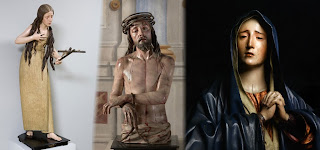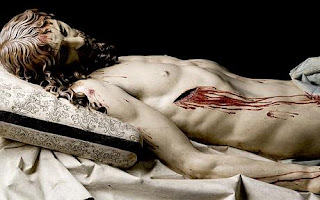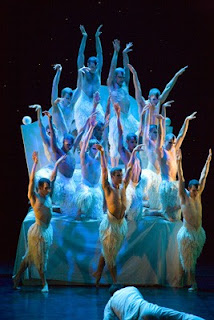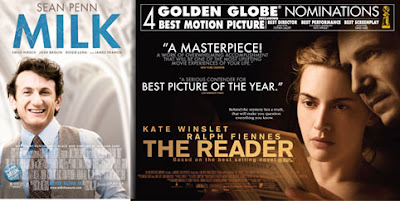 All last week I had it in mind to go to the National Gallery to see the exhibition of Spanish religious art THE SACRED MADE REAL so when did I go Constant Reader? On it's last day on Sunday afternoon of course *rolls eyes* Despite the inevitable throng I am glad I made it.
All last week I had it in mind to go to the National Gallery to see the exhibition of Spanish religious art THE SACRED MADE REAL so when did I go Constant Reader? On it's last day on Sunday afternoon of course *rolls eyes* Despite the inevitable throng I am glad I made it.What do you do when it looks like you are losing your market? You give them something more sensory - when television made inroads into cinema attendance, Hollywood came up with 3-D and Cinemascope... when everyone started downloading films Hollywood came up with...er... 3-D.
As the Protestant Reformation swept Europe, the Spanish Catholic Church made a decision to give the worshippers a more tangible experience. They started to commission both sculptors and painters to work together to bring a new hyper-realism to religious imagery - giving the churchgoer a lifelike rendering of Christ, the Madonna and the Saints to confirm that the faith was real.
Strictly governed by both Church doctrine and the separate Guilds of painters and craftsmen, the works were first sculpted from wood then handed over to the painters to polychrome - painted in many colours - as close to lifelike as possible.

It was the curator Xavier Bray's intention to place these sculptures next to known works by artists such as Velázquez and Zubarán to show how the painters who are known to posterity used the techniques of the polychromed sculptures for inspiration. He certainly succeeded.
Although the exhibition space of 6 rooms was relatively small the marvelous sombre lighting and placement of the exhibits made for a powerful experience.
Time and again I had to refer back to the guide just to double-check what I was looking at - the Madonna attributed to Juan Martínez Montanés' is made all the more breathtaking by the painting by an unknown artist of her vestments, the combination of which makes you want to reach out and touch her silky robes. Placed next to Velázquez' portrait of The Immaculate Conception you can immediately see the connection - especially when you read that the artist had studied in the workshops of the artist Francisco Pacheco in Seville.
 Pacheco's own artistry is illustrated in the life-size
Pacheco's own artistry is illustrated in the life-size  representations of the Saints Francis Borgia and Ignatius Loyola the founder of the Jesuits. These were designed to be able to be dressed in vestments for different religious events so all the artistry was concentrated on the hands and head. One can only imagine the awe these figures generated in the Jesuit brothers who commissioned them, especially as Montanés modelled the one of Loyola from his death-mask. They are beautifully crafted and have a heightened realism thanks to Pacheco's use of an egg-white varnish to make Borgia's eyes glisten and the small glass tears sparkling on Loyola's face. Who knew he invented Glam Rock too? Their cassocks were genuine material that had been coated in glue to give them a leathery, long-lasting quality.
representations of the Saints Francis Borgia and Ignatius Loyola the founder of the Jesuits. These were designed to be able to be dressed in vestments for different religious events so all the artistry was concentrated on the hands and head. One can only imagine the awe these figures generated in the Jesuit brothers who commissioned them, especially as Montanés modelled the one of Loyola from his death-mask. They are beautifully crafted and have a heightened realism thanks to Pacheco's use of an egg-white varnish to make Borgia's eyes glisten and the small glass tears sparkling on Loyola's face. Who knew he invented Glam Rock too? Their cassocks were genuine material that had been coated in glue to give them a leathery, long-lasting quality.
Montanés is also represented by a monumental sculpture of Christ on the cross which - along with all the other works centering on the Passion - offers no redemption, no idea of any passion in fact. Just torture and death. These were made to shock the viewer at the gruesome ordeal of one man for one's sins, to believe you have to be able to almost smell the skin. Next to this sculpture was a massive painting of the crucifixion by Francisco de Zubarán which was originally in a niche above an altar in a small chapel usually viewed through a grill. Zubarán was obviously so familiar with these polychromatic statues that his minutely-detailed painting, when viewed through the grill, was often mistaken to be a real statue.
Zubarán's astonishing artistry was also shown in two remarkable paintings of St. Francis of
 Assisi. In one the monk is seen clasping a skull as he is lit by a shaft of light from above while the other has the Saint standing in a rapturous state, his eyes case upwards to Heaven. Over 200 years after his death, the Saint's tomb was re-opened and it is reported his body was found standing by itself in an immaculately preserved condition. Zubarán has portrayed this in his rather frightening painting.
Assisi. In one the monk is seen clasping a skull as he is lit by a shaft of light from above while the other has the Saint standing in a rapturous state, his eyes case upwards to Heaven. Over 200 years after his death, the Saint's tomb was re-opened and it is reported his body was found standing by itself in an immaculately preserved condition. Zubarán has portrayed this in his rather frightening painting.In the same room there was a small devotional statue by Pedro de Mena who for once did the sculpting as well as the painting. Twenty years after Zubarán painted his full-length portrait, Mena copied the Saint's upright posture but made the image all the more startling by using glass eyes during the construction, the figures teeth are made from ivory and real hair was used for the eyelashes. It was genuinely eerie.
Mena was also represented by three other remarkable sculptures: Mary Magdalene meditating on the Crucifixion, Christ as the Man of Sorrows and the Mater Dolorosa - all three were powerful works, demanding attention and unable to avoid. The gruesome Christ figure was riven with huge drops of thick blood and, while walking around it, I was genuinely shocked to get eye-contact with the averted gaze of the figure. The Mater Dolorosa was a distillation of pure grief.
 There are a couple of heads I should mention!
There are a couple of heads I should mention!
There was a wonderful head of Saint John of God sculpted and painted by Alfonso Cano which would have been used, like Montanés' Loyola and Borges, as a construct to be dressed in vestments so only the head and hands would show. It was a captivating study of humility and piety. The other was Juan de Mesa's frighteningly real and anatomically correct sculpture of John the Baptist's severed head - half-closed eyes, bloodied lips, open windpipe, the works. "Saw"? Bring it.
 Finally there were two works of Christ by Gregorio Fernández as unavoidable as they were
Finally there were two works of Christ by Gregorio Fernández as unavoidable as they were  thought-provoking. The first presented a life-size beaten and whipped Christ which shows that anything Mel Gibson could inflict on Jim Caviezel in THE PASSION OF THE CHRIST, Fernández had shown over 380 years before. Again this sculpture was paired with a painting by Velázquez of the scourged Christ slumped at the whipping post being visited by an angel and a child representing the Christian soul. The angel gestures for the child to look at Christ's whipped and torn back - what Velázquez could only hint at, Fernández can show in full detail.
thought-provoking. The first presented a life-size beaten and whipped Christ which shows that anything Mel Gibson could inflict on Jim Caviezel in THE PASSION OF THE CHRIST, Fernández had shown over 380 years before. Again this sculpture was paired with a painting by Velázquez of the scourged Christ slumped at the whipping post being visited by an angel and a child representing the Christian soul. The angel gestures for the child to look at Christ's whipped and torn back - what Velázquez could only hint at, Fernández can show in full detail.The second work by Fernández was truly the most jaw-dropping. Again a life-size figure of Christ but now after the Crucifixion, lying dead on a shroud. It was a work that challenged you to look at it, again seeming to ram home the idea "this happened, this was real".
Before multi-media there was Fernández! In his depiction of the dead Christ he used glass for the vacant eyes, the horn of a bull for the chipped and discoloured fingernails and even going so far as to paint the bark of a cork tree red and use that for the thickened, dried blood on the shattered knees.
 But for all it's gore, it was a marvel to behold - the artistry in the rendering of the shroud and the loin-cloth was extraordinary and the figure was truly remarkable.
But for all it's gore, it was a marvel to behold - the artistry in the rendering of the shroud and the loin-cloth was extraordinary and the figure was truly remarkable.Like so much in this exhibition, once seen... never forgotten.






























































